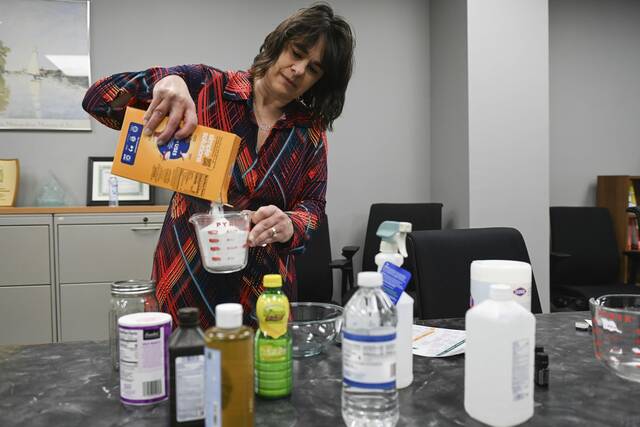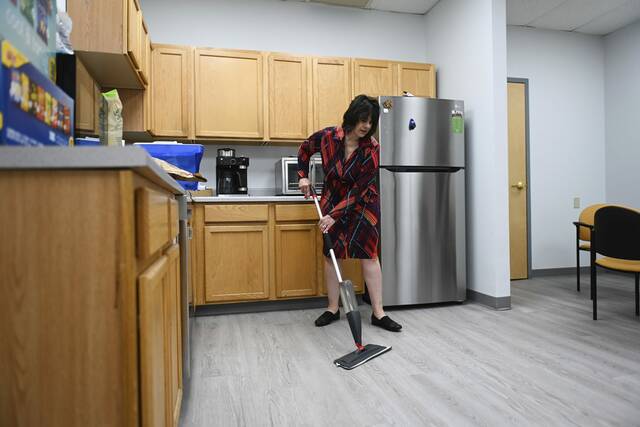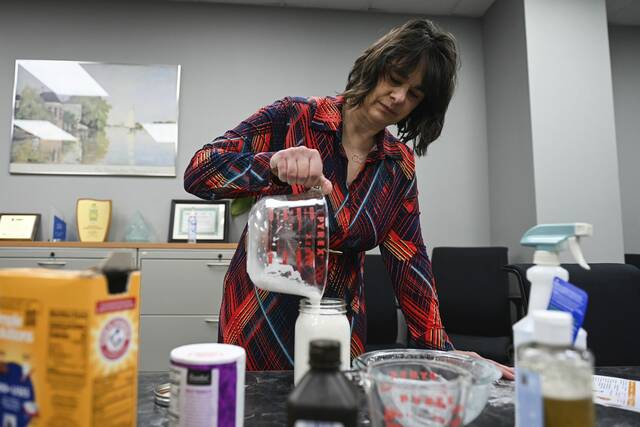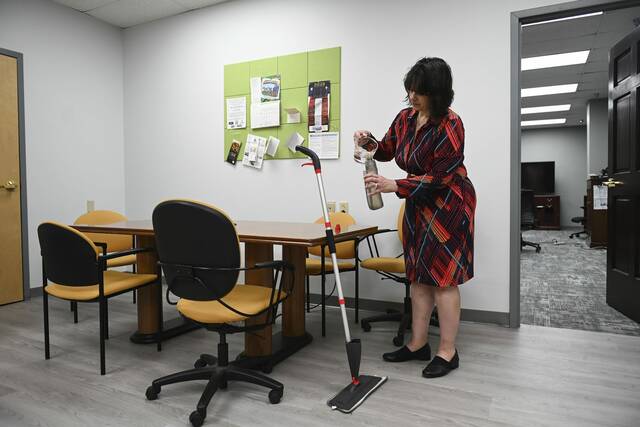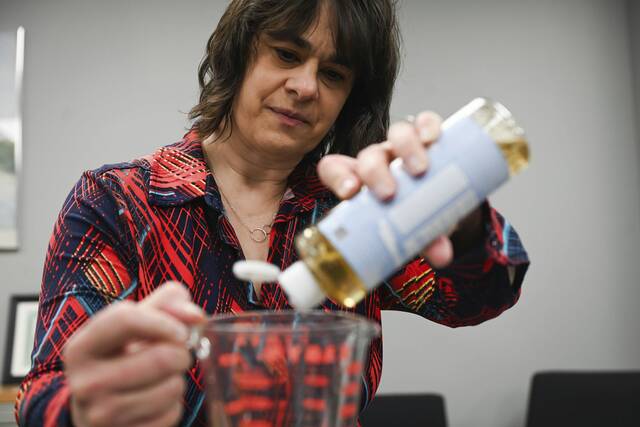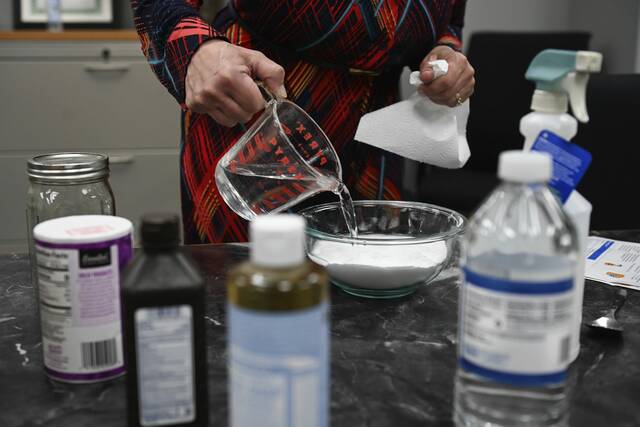Local nonprofit works to educate public on cleaning in a non-toxic way
As homeowners everywhere dive headlong into spring cleaning, a local nonprofit is striving to create more education and awareness around how to do it in a less toxic way.
Women for a Healthy Environment, celebrating its 15th year, offers programming to serve communities across southwestern Pennsylvania. The group aims to educate the public on creating a healthy, non-hazardous home environment.
The nonprofit holds healthy home workshops and offers programming upon request, including community sessions often requested by schools, or faith-based or civic organizations.
“Unfortunately, there is no federal regulation that requires the disclosure of ingredients in cleaning products. So oftentimes, there are products on store shelves that haven’t been vetted for safety or don’t list all the ingredients they contain,” said Michelle Naccarati-Chapkis, executive director of Women for a Healthy Environment.
“What we do is talk about the need for regulations that fully disclose ingredients, like we already see in personal care products.”
California and New York have passed laws requiring that transparency.
While Pennsylvania and other states have not followed suit, there are some signs that can help consumers identify healthier versus harmful products.
As an example, Naccarati-Chapkis advises avoiding products labeled with words such as “poison,” “danger,” “flammable” or “fatal.”
On the flip side, some products have labels that indicate the manufacturer has taken steps to ensure the product has been vetted for human and environmental health and safety.
Many frequently used products, such as bleach, are hazardous to health and can trigger respiratory conditions such as asthma or other health-related issues. Naccarati-Chapkis recommends hydrogen peroxide-based cleaners instead of straight bleach or bleach-based products.
Laura Blood, environmental education coordinator at the Pennsylvania Resources Council, knows well the health issues that can arise from chemicals in household cleaning items including detergents, degreasers and drain cleaners that often contain strong acids.
“We look at things that are endocrine disruptors, anything that, even in small quantities, can make changes to the endocrine system, which can impact the reproductive system, mood and aquatic life,” Blood said.
With the EPA dissolving its Office of Science and Technology and the cuts of more than 1,000 staff members, Blood said, the need for community education and accountability is more important now than ever.
“When I was in college, I remember reading a book that said in the United States, the EPA doesn’t have to assess chemicals before they go on the market,” Blood said.
A 2016 update sought to address that and provide some form of approval before chemicals go out to the market.
“That number of chemicals to be assessed is so huge,” she said. “Even before the proposed cuts, that was a huge challenge … and gutting that department can have huge implications for public health and the environment.
“It puts a spotlight on us to educate ourselves and help each other out in the community, to help people try to be as healthy as they can.”
Understanding the potential ramifications of chemicals in household cleaners, Courtney Clemm, 28, of Friendship, consistently makes her own laundry detergent and hand soap. Vinegar and baking soda are her powerhouses, she said, especially for pots and pans.
She tries to avoid dish soap as much as possible.
It is also important for her to use eco-friendly tools. She has a wooden brush set and plastic-free products.
“I made a lot of swaps that have helped me continue,” Clemm said. “I buy baking soda in bulk from Costco.”
Her laundry detergent recipe includes “baking soda, washing soda, which is like a more powerful baking soda; some sea salt; and sometimes, for an extra clean, I’ll add in a little bit of borax,” she said.
She also has tried Dr. Bronner’s Pure-Castile Liquid Soap in her mix.
“I’m not a big scent girl. I’ve always had really sensitive skin, and my nose is really sensitive to the chemical smells and scents,” Clemm said. “But I have some essential oils that I’ll just drop in there,” .
She uses wool balls in the dryer, dabbed with some essential oil.
For Clemm, the transition came when she was preparing for her newborn, who is almost a year old now.
“The whole concept of just getting his nursery ready, you have to get baby dish soap and baby laundry detergent … and I’m like, what is so bad about what I’m using that my baby can’t use it?” she said.
The research changed her mind.
“It is really easy. If you use lemons for your tea, you can soak lemons in vinegar, and it can be a great cleaning solution,” Clemm said.
Lemon and baking soda have been a go-to for tougher messes.
For now, she sticks to what she knows and keeps it simple, “because you don’t just want to be mixing things together, especially when you are adding heat,” she said.
For those trying to make the transition to safer cleaning while reducing indoor air pollution, it’s important to open doors and windows to keep the space well-ventilated.
Naccarati-Chapkis also cautions against mixing cleaning solutions, as it can create toxic fumes. Avoiding heavily fragranced products is another suggestion, as they can be asthma and allergy triggers.
“I know people like to use plug-ins and spray air fresheners in rooms, but those contain a lot of volatile organic compounds, or VOCs, which are not helpful for human health,” she said.
There are alternative cleaners and natural scents that can be used, such as lavender, lemon and citrus oils.
Another issue is that the term “fragrance” can include hundreds of chemicals under a single ingredient name.
“One of the things being discussed at the federal level is the need to disclose what makes up the term ‘fragrance,’ because it’s currently a source of unknowns,” she said.
The Environmental Protection Agency’s Safer Choice logo indicates that a product contains no ingredients considered carcinogens, reproductive toxins or substances harmful to brain development. These products also avoid ingredients that may harm aquatic life.
“What we use essentially gets washed down the drain,” Naccarati-Chapkis said.
She also recommends looking for products with a Green Seal. Green Seal is a global nonprofit committed to sustainability, and the products that carry its label have been vetted for safety.
A household cleaner database is a useful option offered by the Environmental Working Group. EWG’s Healthy Living app also allows users to scan a product’s barcode to ensure they are purchasing healthier cleaning options.
For anyone thinking of making their own cleaning products, Women for a Healthy Environment provides guidance on DIY cleaning products.
“We’ve actually made everything on our DIY recipe list. We know that they work well,” Naccarati-Chapkis said.
The list includes DIY laundry detergent; multipurpose cleaner; and a window cleaner made with ¼ cup of rubbing alcohol, ¼ cup of white vinegar and 2 cups of warm water, among others.
They promote DIY products because they are made with natural ingredients, which offers transparency.
“You know exactly what’s in them. … And they provide healthier and safer options for everyone in the household,” Naccarati-Chapkis said.
When people discuss vulnerable populations, they often point toward children, the elderly or those those with respiratory diseases who might be immunocompromised.
Young children are often crawling on the floor and putting things in their mouths, Naccarati-Chapkis said, and pets are vulnerable for the similar reasons.
Switching to non-toxic cleaners has other benefits people might not be aware of, including improved levels of water and air pollution.
Since the cost of household cleaning supplies increased by 1.7% from March 2024 to March 2025, according to the Bureau of Labor Statistics, the biggest incentive to switch to natural DIY products might be their cost-effectiveness. Since you don’t need a lot of different ingredients, fewer products are needed.
Naccarati-Chapkis said she uses a multipurpose cleaner made of half vinegar and half water and it works well in her home.
“These are things that are very affordable and effective,” Naccarati-Chapkis said.
Baking soda is also highly effective and has natural scrubbing properties, making it a great option for cleaning tubs and tiles.
“Over the years, we’ve really seen a change in consumer demand. As we share this information, people have been able to make better decisions and influence the marketplace. Companies now know that consumers are demanding this,” she said.
Remove the ads from your TribLIVE reading experience but still support the journalists who create the content with TribLIVE Ad-Free.

